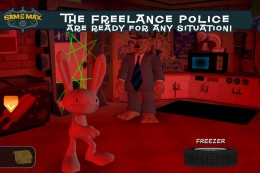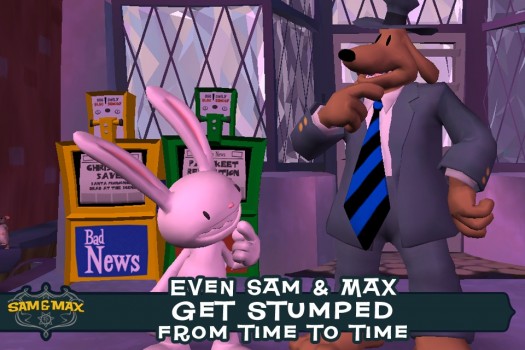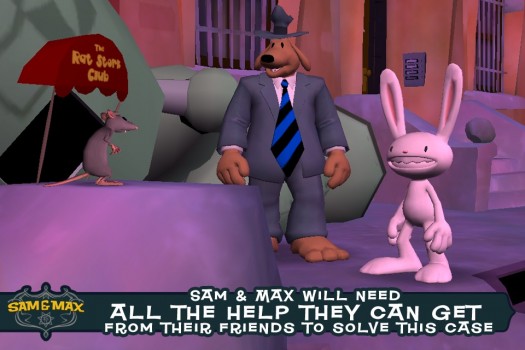![]() Buying an episodic game is equal parts gambling and Kickstarting. “Moai Better Blues [$4.99]," the second game in Sam & Max Beyond Time and Space, takes place right after the delightful “Ice Station Santa [$4.99]," which means the entire series is meant to be taken as a whole. Telltale is banking on its audience’s willingness to buy every episode, hoping that they feel invested enough in the series’ overarching framework to not skip episode two, even though it’s weaker than the first.
Buying an episodic game is equal parts gambling and Kickstarting. “Moai Better Blues [$4.99]," the second game in Sam & Max Beyond Time and Space, takes place right after the delightful “Ice Station Santa [$4.99]," which means the entire series is meant to be taken as a whole. Telltale is banking on its audience’s willingness to buy every episode, hoping that they feel invested enough in the series’ overarching framework to not skip episode two, even though it’s weaker than the first.
“Moai Better Blues" is still a good iOS port, and the presentation, stability, and touch implementation that made the first episode so successful are still featured. Unfortunately, the clunky, tepid mini-games from “Ice Station Santa" also return to the fold.
Like “Ice Station," “Moai" requires a certain amount of preternatural gymnastics: the Freelance Police travel through the Bermuda Triangle to Easter Island, where they’re tasked with appeasing a vengeful, volcanic deity. It’s silly, sure, but it suits Sam & Max‘s particular brand of clunky, in-game logic.
The beauty of Sam & Max, though, is that this logic rarely feels unfair or internally inconsistent: “Moai" is a classic inventory-management type of point-and-click adventure, but all of the puzzle solutions are backed up diegetically by conversations with other characters. If you pay attention, “Moai Better Blues" is more than happy to tell you the solution to each puzzle.
This dovetails nicely with Telltale’s efficient use of space, as each area is densely packed with items and off-hand bits of dialogue. Interacting with items and gathering clues is vital to Sam & Max, which creates a sort of self-sustaining momentum: the puzzles force players to search for clues, experiment with items, and talk to people, which in turn reveals the world’s humor and charm. As a result, “Moai"‘s Easter Island feels vibrant and well-realized, even though it consists of only five or six screens.
 If “Moai" exceeds “Ice Station" at all, it’s that it, mercifully, keeps aimless wandering and backtracking to a minimum. The Bermuda Triangle allows Sam and Max to travel freely between their office and Easter Island, but “Moai Better Blues" is pared down and focused enough that most most of the game is self-contained on the island.
If “Moai" exceeds “Ice Station" at all, it’s that it, mercifully, keeps aimless wandering and backtracking to a minimum. The Bermuda Triangle allows Sam and Max to travel freely between their office and Easter Island, but “Moai Better Blues" is pared down and focused enough that most most of the game is self-contained on the island.
Nevertheless, whereas “Ice Station" was particularly good at allowing players to chart each puzzle to its conclusion, “Moai" trends toward murkiness. I found myself solving puzzles in “Moai Better Blues" simply because they were there, waiting to be tinkered with, but not because I could tell how they would help me in the larger scheme of things. In “Ice Station," each puzzle has an obvious context in the game as a whole; “Moai" often lacks this context. This might not a problem per se — design by tautology has been a genre staple for a long time by now — but “Ice Station Santa" was refreshing in its clarity, and “Moai Better Blues" is much less explicit in its expectations.
The game’s middle section may stumble about, but its climax is deft: the identity of “Moai"‘s volcano-deity antagonist is a perfect marriage of Steve Purcell’s surrealist vision and his acknowledgment that Sam & Max fans need to feel that each episode is connected for the series to work. I don’t want to spoil the big reveal, and it’s a terrible shame that “Moai" deflates all that good will with a particularly boring final puzzle. “Boss fight" puzzles have become a staple of the episodic Sam & Max games, but “Moai"‘s finale is derivative, logically obtuse, and awkwardly executed.
“Moai Better Blues" skates by on its pedigree and the humor and charm of Purcell’s vision, and its simplistic final puzzle does little to inspire confidence for the inevitable release of episode 3, “Night of the Raving Dead." Still, Telltale are skilled craftsmen, and they’ve been refining Sam & Max‘s episodic content for a whopping seven years by now — even at its worst, it’s hard to go wrong with “Moai Better Blues."


